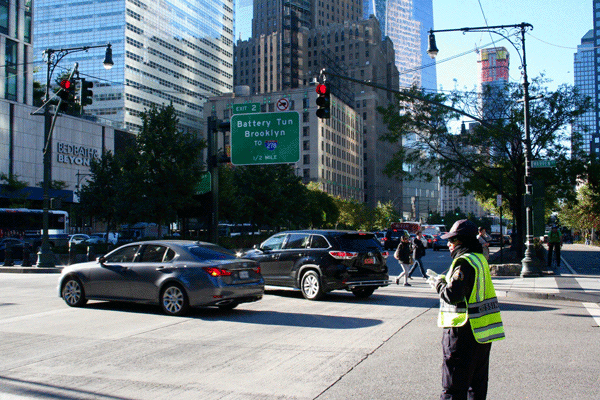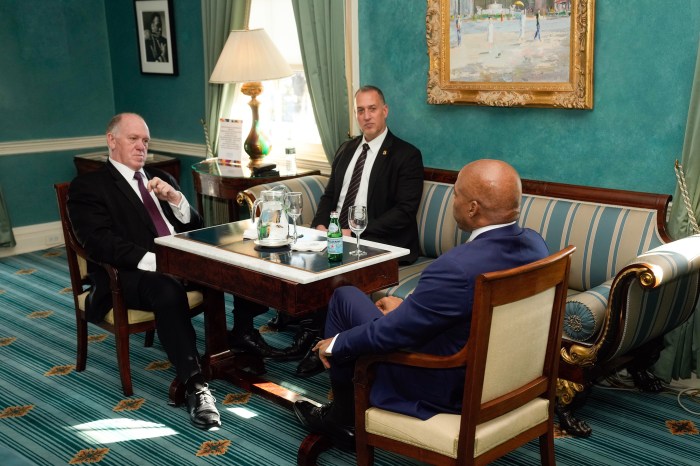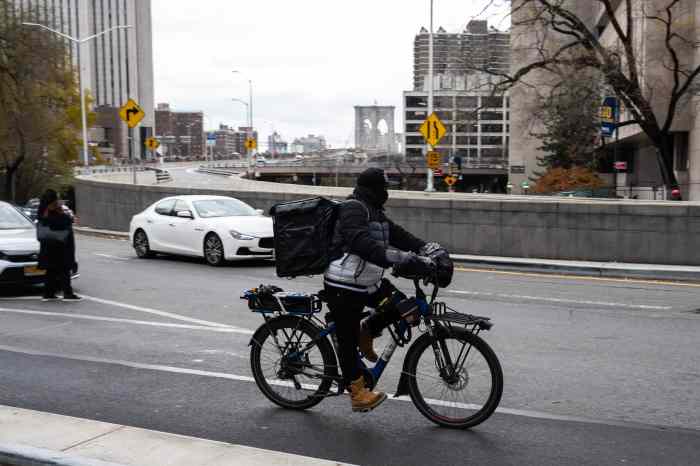
Downtown’s chronic shortage of crossing guards may finally end, thanks to reforms by the city to make the job more attractive.
BY DENNIS LYNCH
Mayor Bill de Blasio has committed more than $25 million through 2020 to guarantee dedicated crossing guards at all school posts citywide, and some of that funding will go towards reforms that may help solve the chronic understaffing that has plagued Lower Manhattan.
The reforms, including pay raises across the board and the creation of a supervisor position, could help the city fill long-empty crossing-guard slots around Downtown schools. The city plans to hire 100 full-time supervisors and 200 additional part-time guards citywide, as well as establishing a “mobile replacement squad” to ensure coverage at all posts, according to the Mayor’s office.
An agreement with Local 372, the union that represents crossing guards, will create a new, full-time “level 2” supervisory guard position to oversee scheduling, log shifts, and ensure coverage at school intersections. Starting next school year the city will also bump the pay for “level 1” part-time guards from a starting $11.50 an hour to $15 an hour, with the opportunity to go up to $18 an hour after three years employment, according to the union.
Supervisors will make 10 percent more than what part-time guards make, but more importantly, they will have a full, 40-hour week, plus benefits. They take over from police officers who acted as “school crossing guard coordinators” on top of their other uniformed duties. Supervisors will work 10-hour days from 6:30 a.m. to 4:30 p.m. with a two-hour lunch break, according to the Mayor’s office.
The new agreement goes into effect immediately and the city has already started hiring full-time supervisors, according to Local 372 president Shaun Francois. Francois believes the prospect of upward mobility from part-time to full-time will help retain new recruits.
“What’s going to happen now is twofold — they have no glass ceiling, they know they may become level two. They didn’t have that mindset before. And the raise is going to do that as well,” he said.
The First Precinct will get funding for two additional part-time guards, bringing the total there to nine. The Fifth Precinct will also receive funding for two more additional guards, bringing the total there to 28. This does not create new posts in either precinct — the additional guards will help cover and fill vacancies at existing posts.
Critics have blamed the position’s low pay and meager 25-hour week for hampering efforts to hire and retain Downtown crossing guards in recent years. The police department has hired guards in the past and couldn’t find enough people to fill Downtown posts in the last two school years. There are currently only two dedicated crossing guards working for the First Precinct, and the precinct has had to fill vacant positions with Traffic Enforcement Agents, according to the First Precinct.
Community Board 1 Youth and Education Committee co-chair Paul Hovitz said he hoped the precinct would be able to replace all traffic agents with dedicated guards, particularly with folks from the neighborhood. He hoped that health benefits would attract more people to both part-time and full-time jobs.
“For people who are fortunate enough to be assigned near where they live and don’t have to pay for travel, even a couple hours pay along with the benefits are certainly the motivating factor,” he said. “That’s a big deal.”
He said Downtown’s street grid — or lack thereof — presents unique dangers for students. A taxi struck a 16-year-old Millennium High School student last month while she was crossing Broad St. and luckily she sustained no life-threatening injuries. Crossing guards are not assigned to high schools anywhere in the city, but the incident is indicative of the dangers facing students of all ages and pedestrians in general.
“CB1 is the fastest-growing residential community in New York City, in addition to having narrow streets, inordinate amounts of construction, and sidewalk sheds — all things that obviate Vision Zero for drivers,” he said.
Hovitz also wondered how many part-time employees would actually have the opportunity to move up to supervisor.
“That is for someone with children particularly a key factor. We know what health care costs, and chances are costs are due to skyrocket with the new [presidential] administration’s plans,” Hovitz said.
Hovitz, Councilmember Margaret Chin, and others want the city to move crossing guards under the purview of the Department of Education (DOE) to allow them to work in other school safety roles in the five hours between morning and afternoon guard shifts.
Francois said he eventually wants to “annualize” guards to work year-round and find a way to pay them for a full eight-hour day, but said that he was not familiar with proposals to move guards to the DOE.
The funding starts at $5.4 million for fiscal year 2017 and gradually increases between a million and a half a million dollars each year until it reaches $7.2 million in 2020.





































